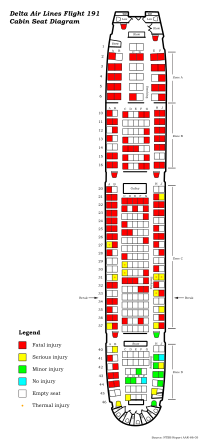Delta Air Lines Flight 191
The aircraft impacted ground just over one mile (1.6 km) short of the runway, struck a car near the airport, collided with two water tanks and disintegrated.
Forecasts of microbursts improved in the following years, with USAir Flight 1016 being the only subsequent microburst-induced crash of a commercial, fixed-wing aircraft in the United States as of 2025[update].
[4]: 92 The National Transportation Safety Board (NTSB) mentioned in its final report that past flight crews who had flown with Connors described him as a meticulous pilot who strictly adhered to company policies.
"[4]: 6 Since his qualification in 1979, Connors had passed all eight en route inspections that he had undergone; the NTSB report also noted that he had received "favorable comments" regarding "cockpit discipline and standardization.
[13][14] Among the deaths was Don Estridge, known to the world as the father of the IBM PC; he died aboard the flight along with his wife.
[4]: 1 [17][c] The flight's dispatch weather forecast for DFW stated a "possibility of widely scattered rain showers and thunderstorms.
"[4]: 1 Another dispatch weather alert warned of "an area of isolated thunderstorms ... over Oklahoma and northern and northeastern Texas.
The flight crew decided to deviate from the intended route to make the more northerly Blue Ridge arrival to DFW.
At 17:35, the crew received an Automatic Terminal Information Service (ATIS) broadcast for weather on approach to DFW, and the Fort Worth Air Route Traffic Control Center (ARTCC) air traffic controller cleared the flight to the Blue Ridge, Texas, VORTAC and instructed the flight to descend to 25,000 feet (7,600 m).
[4]: 2 The controller suggested they fly a heading of 250° toward the Blue Ridge approach, but Connors replied that the route would take them through a storm cell, stating, "I'd rather not go through it, I'd rather go around it one way or the other.
"[4]: 122 [18] Around the same time, Connors switched to the arrival radio frequency and informed the approach controller that they were flying at 5,000 feet (1,500 m).
[4]: 3 Half a minute afterward, the controller asked the flight to reduce their speed to 160 knots (180 mph; 300 km/h), which the crew acknowledged.
[4]: 3 While on final approach, the Learjet flew through the storm north of the airport and encountered what was later described as "light to moderate turbulence".
The Learjet encountered heavy rain and lost all forward visibility, but was able to continue its ILS approach and land safely.
[4]: 4 [22] The captain responded by declaring "TOGA", aviation shorthand for the order to apply maximum thrust and abort a landing by going around.
[4]: 25, 40 The main landing gear left shallow depressions in the field that extended for 240 feet (73 m) before disappearing and reappearing a few times as the aircraft approached Texas State Highway 114.
The left horizontal stabilizer, some engine pieces, portions of the wing control surfaces and parts of the nose gear came off the aircraft as it continued along the ground.
[4]: 28 The tail section emerged from the fireball, skidding backward and came to rest on its left side before wind gusts rotated it upright.
In later testimony to NTSB officials, on-site EMTs estimated that without the on-scene triage procedures, at least half of the surviving passengers would have died.
The remainder of the surviving passengers and crew were in the rear cabin and tail section, which separated relatively intact and landed on its side in an open field, and most of these were in the center and right portions of the fuselage from seat row 40 rearwards.
[citation needed] After a long investigation, the NTSB deemed the cause of the crash to be attributable to pilot error (for their decision to fly through a thunderstorm), combined with extreme weather phenomena associated with microburst-induced wind shear.
[4]: 1 [28] The NTSB also determined that a lack of specific training, policies, and procedures for avoiding and escaping low-altitude wind shear was a contributing factor.
[32] Pilots were also required to train to react to microbursts and to quickly take evasive action in order to safely land the plane.
[33][5][34] The Delta Flight 191 crash resulted in the longest aviation trial in American history, lasting 14 months from 1988 to 1989 and presided over by Federal Judge David Owen Belew Jr. of the Northern District of Texas.
While the use of such animation later became routine, its use in the Flight 191 litigation was sufficiently novel that it became the cover story of the December 1989 ABA Journal, the magazine of the American Bar Association.
[37]: 52 Preparing the animated video for trial cost the Department of Justice around $100,000 to $150,000 (inflation adjusted $250,000 to $370,000), and required nearly two years of work.
[38] The Discovery Channel Canada/National Geographic television series Mayday dramatized the crash of Flight 191 in a season-five episode titled "Invisible Killer".
[43] The article explored the topic of survivor guilt and earned Connelly and his co-writers a finalist position for the Pulitzer Prize.
[44] Ten years after the crash, survivors and family members of victims gathered in Florida to recognize the tenth anniversary of the accident.
[46] This article incorporates public domain material from websites or documents of the National Transportation Safety Board.



